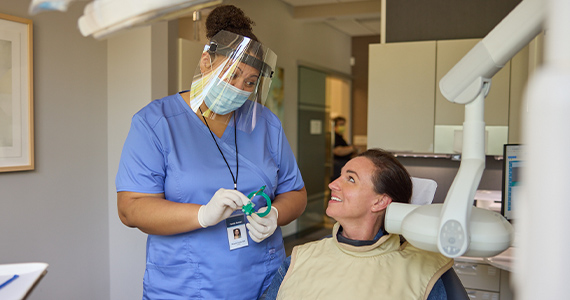Do I need a root canal?
Call your dentist and save your tooth.

What Leads to a Root Canal?
When cavities are left untreated, bacteria travel deep into the tooth pulp and nerve. The pulp houses the blood supply and nerve for the tooth. Bacteria can cause the pulp to become inflamed, leading to pain, sensitivity to pressure or temperature and, possibly, nerve damage. With inflamed pulp, the blood supply to the tooth can be reduced or cut off completely. Without a blood supply, the pulp can die and an abscess may develop.
Once a tooth has died, it can become discolored and will lose sensitivity. Treatment options for a pulp infection or dead tooth are generally limited to a root canal treatment or extraction.
Tooth Infections and What to Expect During a Dental Exam for Them
Do not wait until a minor toothache becomes an emergency to visit your dentist. A developing infection can become life-threatening. It may also be a challenge to get a same-day appointment with your dentist, so you may have to sit and wait before you can be seen for the problem.
Once you're seated for an examination, your dentist will perform more diagnostics on the pulp. You may have an X-ray taken and the dentist may perform a few tests to determine if the tooth is still alive. These may include:
- Percussion Test - Your dentist will tap gently on the tooth with a dental tool to check if the tooth is responsive.If the gentle tapping causes pain, the pulp (nerve) of the tooth may be dead. It can also show if an infection is present and the tooth needs a root canal.
- Temperature Test - Your dentist may do a temperature test by applying a cold spray on a cotton swab and placing it on your tooth for 5-10 seconds. If you do not feel the cold, the pulp of your tooth may be dead and in need of a root canal. A prolonged/lingering response is a sign that the pulp is inflamed. Your dentist may ask more questions or do more tests to diagnose the cause of your concern.
Can the Tooth be Saved?
Your dentist will consider several factors when making this decision, including how much tooth structure is left and if there's enough bone density around the tooth.
Your tooth is held in place by bone and ligaments. If there is enough bone to support the tooth, it is usually able to be saved. However, if you notice it is wiggly, there's a chance it may have to be extracted.
If the tooth has broken and you're missing some of it above the gum line, your dentist may be able to save it by doing a build-up and adding a filling material to the tooth. A crown is typically recommended upon completion of a root canal and build-up.
The sooner you visit your dentist regarding a toothache, the greater the chance of saving the tooth. Your dentist is the best judge as to if a tooth can be saved. Their goal is for you to keep as many natural teeth as possible.
Root Canal Procedure: Single Appointment vs. Two Appointments
A root canal may be completed in a single appointment or require two appointments. A second appointment may be needed if there is infection present.
- Single appointment - If no infection is present, your dentist may complete the procedure.
- Two separate appointments - If infection is present, your dentist will remove the infected pulp and nerve, disinfect the root canal and place a temporary filling. This process is called a pulpal debridement, which treats the pain and allows time for you to take antibiotics to clear the infection. With a temporary filling, you should not eat sticky food, such as caramel, or chew gum because it may dislodge the material. During the second visit, your dentist will complete the root canal treatment.
How to Avoid a Root Canal
Root canal treatment can be time-consuming and expensive. The best way to avoid it is to have regular dental exams and cleanings every six months. This way, your dentist and hygienist can monitor your oral health and address any potential issues right away.
Always be sure to practice good oral hygiene by brushing for at least two minutes, twice a day, and flossing at least once a day. This will reduce the bacteria in your mouth and your risk of tooth decay.
Note: The information in this document is not meant to replace the advice of your dentist or another licensed healthcare professional. Talk to your dentist for any specific dental advice.






